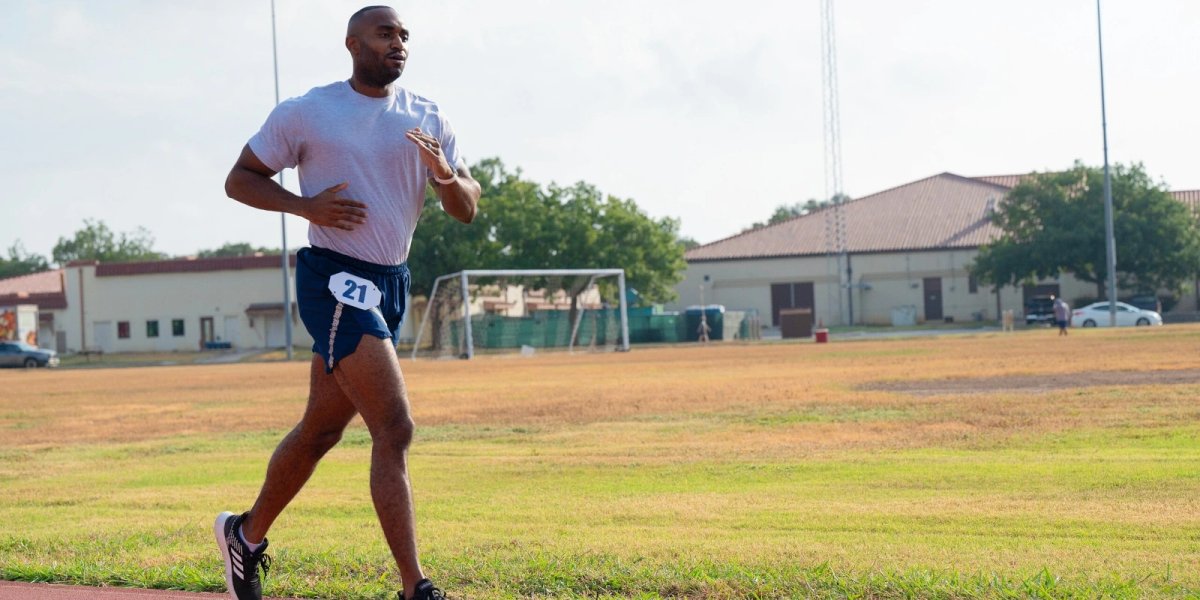AIR FORCE ADDS TWO-MILE RUN TO PHYSICAL FITNESS TEST

After decades of taking flak from their Army, Navy, and Marine brethren for the perceived “easiness” of their physical fitness test, Airmen will soon have a test that’s on par with the sister services. The biggest change to the new USAF Physical Fitness Assessment (PFA) relates to the cardiorespiratory assessment portion of the test, which, in the past, consisted of a 1.5-mile run. The new PFA increases the length of the run to two miles, the same distance used on Army fitness tests. Of course, the USAF will not adopt the deadlift and sprint-drag-carry elements of the Army fitness test. So, you still may catch some flak from your Army pals.
Before formally implementing the new PFA, the USAF will pause all testing on January 1, 2026, and begin a diagnostic period from March 1 to Aug 31, so Airmen can become acclimated to the new test.
On September 1, 2026, the new PFA will be formally implemented, with Airmen required to take the test once every six months, regardless of their score on the test. In the past, Airmen who scored high enough on their PFA were only required to test once per year. Sorry, folks, that isn’t going to cut it anymore. Plus, the two-mile run must be accomplished on at least one of the two tests each year.
Under the new policy, Airmen must take a cardiorespiratory assessment at both PFAs each year, but only one of those assessments has to be the two-mile run. For the other PFA, an Airman can choose to do either the two-mile run or the 20-meter High Aerobic Multi-Shuttle Run, where participants dash between lines 20 meters apart at progressively faster pace.
Air Force Physical Fitness Assessment: New Components
The new PFA consisted of four components:
- A two-mile run, which tests the Airman’s cardiorespiratory fitness and counts for 50 percent of the total score.
- Push-ups or hand-release push-ups completed in one minute. Hand-release push-ups require Airmen to lower their chest all the way to the ground and extend their hands out to the sides before pushing up again. This component measures muscle strength and counts for 15 percent of the total score.
- Sit-ups or reverse cross leg crunches completed in one minute or a forearm plank test, which measures muscle core endurance and counts for another 15 percent of the total score.
- A body composition test where Airmen divide their waist length by their height in inches. For example, an Airman who stands 69 inches tall and has a waist of 36 inches would have a waist-to-height ratio of 0.52. This component counts for 20 percent of the total score, but Airmen do not have to take the body composition test the same day as the workout portion of the PFA.
Air Force Fitness Standards: Stricter Requirements
In the current version of the test, Airmen can squeak by just achieving the minimum score in each category, since that score would add up to the minimum passing score of 75 points.
The new test is structured to prevent Airmen from using this technique. You can see the new scoring charts for the PFA here.
Body Composition May Be Done Separately
Under the new Physical Fitness Assessment (PFA), Airmen are no longer required to complete the body composition portion on the same day as their PFA.
This change addresses a concern raised in 2019, when officials observed that combining both events on the same day sometimes led to Airmen engaging in potentially dangerous practices, such as starvation or diuretic use, to meet measurement requirements, especially when combined with physical training.
Different Standards for Ages and Sexes
As in the past, the new PFA standards will vary by sex and age group for Airmen.
However, specialized fields like special warfare and explosive ordnance disposal will continue to adhere to their existing, unique fitness requirements.
Air Force Fitness Test Guidelines: Upcoming Changes
The Air Force will also release a new publication called “The Warfighter’s Fitness Playbook.” It will provide guidance to Airmen and Guardians, reinforcing the service’s efforts to ensure service members safely, healthily, and effectively meet fitness and readiness standards.
According to a USAF press release, “The Warfighter’s Fitness Playbook” is an adaptive and agile resource for Airmen and Guardians for implementing fitness and lifestyle management programs to include sleep and nutritional tips, and exercise and fitness guidance.
"These fitness changes are about having a healthy, ready force prepared to meet today’s mission and the demands of the future fight," said U.S. Air Force Chief of Staff Gen. David Allvin. "The updated model reflects our high standards for fitness and ensures our Airmen have the tools they need to protect their long-term health."
Suggested reads:
National Security Analyst
George Riebling
Air Force Veteran
George Riebling is a retired USAF Colonel with 26 years of distinguished service as an Air Battle Manager, including operational assignments across fi...
Credentials
- Retired USAF Colonel, 26 Years Service
- Former NATO Senior Executive (10 years)
- Boeing Strategy and Business Development (2 years)
- Operational experience across 5 Command and Control weapon systems
Expertise
SHARE:



